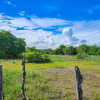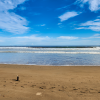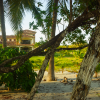Strange Paradise
Image credit: Gavriel Jecan/Corbis
Also see:

Video: "Panama's Brooding History"
Bill Donahue narrates a photo tour of Panama's jungles, wildlife, Cold War ruins, and odd national park-cum-penitentiary.The birds, I learned later, were toucans. But as I made my way through the Panamanian jungle, their dry, echoing call—whoosh, whoosh, whoosh—sounded almost mechanical, which seemed fitting. Before me, on an open plain in the Galeta Island Protected Landscape, was a mesh of 100-foot-high wires used by the United States during the Cold War to monitor Soviet submarines.
“They used to have a phone that connected straight to the White House,” my guide, a Panamanian student, remarked somberly. “And there was an underground tunnel soldiers could use to escape right out into the ocean.”
Of course, neither the tunnel nor the phone ever existed. But they were lovely details, embodying the mystique of Panama today. As the nation vaults toward prosperity, with an 8 percent average annual GDP growth rate, it is still haunted by its past—by the seven-year rule of Manuel Noriega, and by nearly 100 years of American soldiers guarding the canal. Noriega and the GIs left behind mementos that collectively have the dark, exotic ambiance of a Graham Greene novel. They also left behind pristine jungles—the U.S. allowed no logging in the rainforest surrounding the canal, because the trees afforded cover from potential attacks—and a serious ecotourism industry is sprouting up. So I went south for a few days, bringing my flip-flops and snorkeling gear.
Thirty minutes outside Panama City is a former radar tower that the U.S. once used to monitor the canal. Lavishly renovated, the three-story cylinder is now the Canopy Tower hotel, a mecca for serious birders. From the roof, you can see parrots and parakeets swooping through the mist and the trees. Birdwatching’s high Brahmins—Jimmy Carter, Jimmy Buffett, Martha Stewart—have all stayed here.
When I visited, there was a group, eight strong, from a Texas-based tour company. I joined them in the open-air “Rainfomobile” for three hours of hushed observation. For 20 minutes, we stood by a swampy pond, trying to home in on a small fluttering piratic flycatcher in the brambles. “If you look up at that branch there,” the guide whispered, “and follow it to that little knob— ”
 |
| The Canopy Tower hotel, a former U.S. radar installation, is surrounded by virgin rainforest and exotic wildlife. Photo credits, clockwise from left: David Tipling/Alamy, Kevin Schaffer/Alamy, Paul A. Souders/Corbis |
“I got it!” one man cried. “I got some butt!”
I found myself yearning for a grittier encounter with the country’s past, and thought I might find it on Coiba Island, 15 miles off Panama’s Pacific coast. A penitentiary since 1919, Coiba is now the centerpiece of a bounteous national park, Galápagos-like, with more than 20 endemic bird species. It is also still a prison, though with only a handful of inmates.
In Santiago, four hours south of Panama City, I met up with a guide taking 17 others—Panamanians on holiday, mostly—to the island. We rode in a minivan for two hours, walked a couple of miles along a dirt road, and then piled into an aluminum outboard. “Paraíso!” our guide declared when at last we drew near. “Es como Hawaii!”
Maybe—with a little Guantánamo thrown in. On the beach, we were greeted by a jaunty, 60-something man with a gun—a prison guard. Around us were some 3,000 cows. The guard explained that they were there thanks to a bureaucratic snag: “The prisoners used to butcher the herd, but now the Ministry of Justice doesn’t allow it, and the cows can’t leave—they’d die of shock on the boat.”
We meandered past a grove of trees, and in the branches was a small, skittish bird that I loved as much for its name in Spanish as for its appearance. Sangre de toro is a tanager with a breast and throat carpeted, it seemed, with crimson velvet. Nearby, a sleek jackrabbit-like mammal, a neque, fidgeted on the ground, its back hunched, its eyes bulging. Howler monkeys, smaller than their mainland cousins, bounded in the branches above.
After a while, we met a man chopping vegetables who is serving a 16-year sentence for murder. He asked me to sit down beside him, and quietly extolled the joys of Coiba. “The fresh air!” he said. “The peace!”
I asked what he did with his time.
“Cook,” he said, “and take care of the cows—make sure they don’t die. Like, if the little ones get caught in the sand, we help them out.”
He was so placid that I found our conversation disorienting. What kind of murderer was this guy? And what kind of country would let tour groups hang out with murderers? On Coiba, I often felt somewhat disoriented. I like to swim long distances, and every time I strapped on my goggles, a young Panamanian raised his hand and warned, “Los tiburones!” The sharks! I couldn’t tell if he was joking. For all I knew, Coiba is home to sharks that feast on gringos. But still I swam with abandon: over coral reefs, and scuttling crabs, and twisting schools of electric-blue fish.
One time, I misunderstood our guide and jumped in while everyone else stayed on the boat. I was alone in the water when a giant black manta ray came billowing along, headed shoreward. Its body was boneless; it moved like a flopping prehistoric bird in slow motion. As it passed by I just watched it, savoring another strange delight in a strange land.






